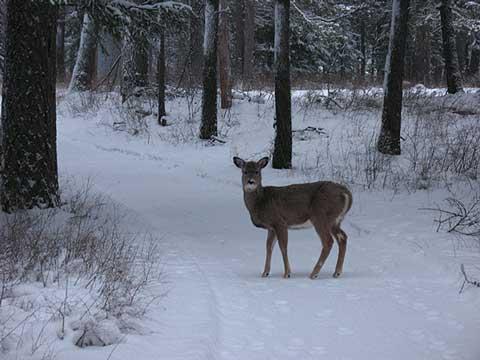The calendar and Mother Nature are in agreement at Glacier National Park in Montana: the winter season has officially begun, and most roads in the park are closed to vehicles and open for cross country skiing and snowshoeing.
Park officials have announced that recent snow accumulation in Glacier National Park has prompted vehicle traffic restrictions on most park roads that had previously remained open for motorized traffic. With the arrival of the holidays, people are thinking about winter recreation in and around the park, and visitors will find sufficient snow for cross country skiing, snowshoeing and other non-motorized winter recreation.
Conditions permitting, it's still possible for vehicle traffic to use the lower elevation portions of both the east and west side of the Going-to-the-Sun Road. All other park roadways are now closed to motorized vehicle traffic for the winter.
Throughout the winter, the National Park Service plows and maintains the west side of the Sun Road from West Glacier to Lake McDonald Lodge, a distance of 11 miles. On the east side of the park about one mile of the Sun Road, from the St. Mary entrance to the gate at the St. Mary campground, is normally open. Depending upon local road and weather conditions, those distances open to vehicle traffic may vary from day to day.
Other park roads will not be plowed and snow will be allowed to accumulate for non-mechanized recreational use. Rehabilitation work on the Sun Road is finished for the winter and will resume in the spring of 2010.
The park website has information about skiing and snowshoeing opportunities in Glacier, including several suggested routes.
If you're a fan of winter camping, you'll find two opportunities at park facilities.
Winter camping (no water) is available in the park at Apgar Picnic Area and St. Mary Campground. There is no cost for winter camping; however, a valid entrance pass is required.
Winter backcountry travelers are reminded that backcountry permits are required for all overnight backcountry trips. Winter permits are available, at no charge, Mondays through Fridays at park headquarters, 8 a.m. to 4:30 p.m. and on weekends at the Apgar Visitor Center from 9 a.m. to 4:30 p.m.
It's essential that anyone traveling into the interior of the park keep safety—and the weather—in mind. You'll find a link to the National Weather Service forecast on this page. Forecasts for remote mountain areas can be tricky, and since the Continental Divide runs through the park, weather can vary considerably from the west to the east side of Glacier. A very general rule of thumb is that the west side of the park tends to receive a bit more snow, while conditions may be winder and colder on the east side of the Divide.
Winter weather in the northern Rockies can change very rapidly. During one of my winters in the park, we received 39 inches of snow overnight at East Glacier, along with considerable wind. Under those conditions, even the expert local plow operators can't keep up! As is true for any travel in serious winter country, visitors should be prepared and equipped for an unexpected and extended stay if conditions dictate a change in plans.
Avalanches are a real danger in the mountainous portions of Glacier. The park suggests visitors check for the latest avalanche hazard and weather advisory at the Glacier Country Avalanche Center website before entering the park’s backcountry.
Information to help you plan a visit is available on the park website; this link has current road conditions, updated as conditions change. Road condition reports are also available via two toll-free phone numbers for the Montana Department of Transportation Traveler Information System: 511 in most of Montana or 1-800-226-7623 elsewhere. Select “Glacier Park Tourist Information” from the main menu to hear Glacier’s road report.




Add comment